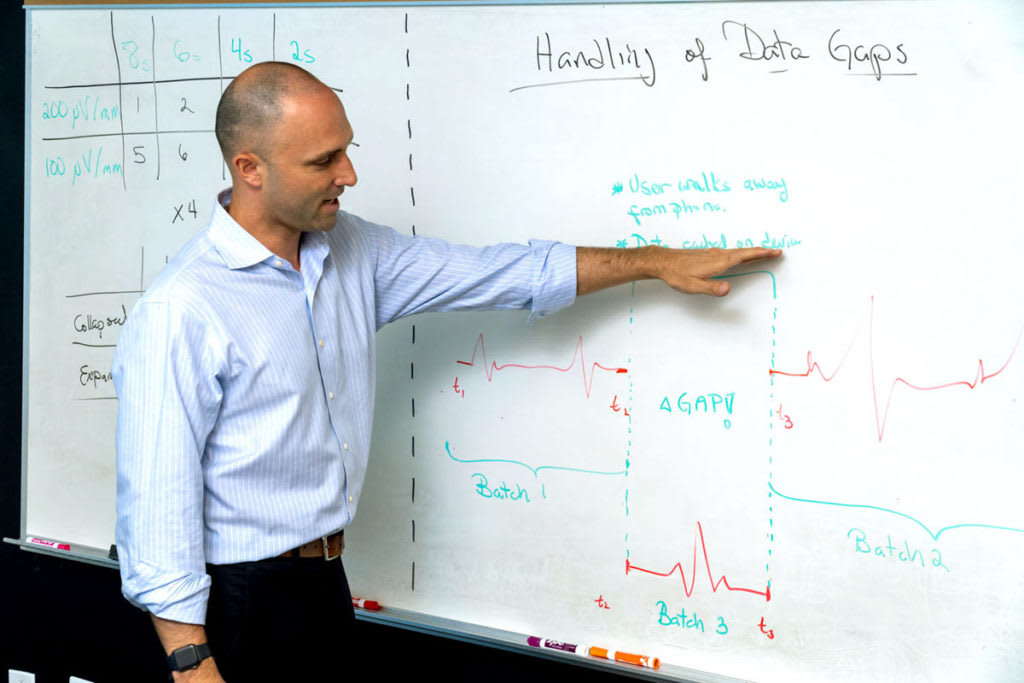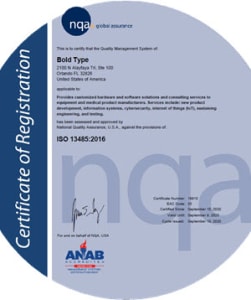3 questions to ask before picking a connected medical device product development firm

Choosing the right product development partner can be a daunting task.
The wrong choice can cost you months (or years!) and millions of dollars.
Ask these 3 questions so you confidently can embark on your journey with your ideal medical device product development firm:
Q1: What types of products do you develop?
“We can develop anything” is absolutely the wrong answer. There are plenty of product development firms with expertise in your focus area.
Don’t settle.
If you need to connect your medical device to the cloud, get a product development firm that focuses on medical device connectivity.
At Bold Type, we focus on connected, wireless medical devices. Here’s what that means:
 Medical Devices. “Medical devices” means we use an ISO 13485 quality management system, to create Design History Files (DHFs) that withstand FDA review or audit scrutiny. We hire purpose-driven engineers and designers who feel compelled to improve patient outcomes. (Bold Type invested the time and effort to become 13485:2016 certified.)
Medical Devices. “Medical devices” means we use an ISO 13485 quality management system, to create Design History Files (DHFs) that withstand FDA review or audit scrutiny. We hire purpose-driven engineers and designers who feel compelled to improve patient outcomes. (Bold Type invested the time and effort to become 13485:2016 certified.)
Wireless. “Wireless” means our hardware and software engineers are intimately familiar with all primary wireless modalities: Bluetooth/BLE, WiFi, cellular, ISM, and more.
Our strategic advantage: We’ve worked on so many wireless projects, we have reusable code and schematics primed to accelerate your progress. It’s nice not reinventing the wheel each time.
Connected. “Connected” means we understand how to build mobile, web, and cloud applications to interface with the device and transfer the data to the cloud. What’s more, we know developing medical software is vastly different than non-medical software development, and we’ve set our systems and processes accordingly.
In sum. If you don’t need wireless communications or cloud connectivity, we’re probably not your best option.
- New MRI machine? Not us.
- Electric scooter? Nope.
- Handheld ultrasound machine for patient home use? Ding, ding, ding! We’re a great fit.
You don’t need a partner who’s done your exact product – just one who specializes in similar products.
Q2: What typical challenges should we anticipate during the product development process?
The response to this question will tell you a few things:
- Is this a team you can trust?
- Is this team competent?
- Does this team have adequate experience developing similar systems?
Let’s explore each in turn.
Is this a team I can trust?
Choosing the right partner to develop your product is like choosing a life partner. It’ll be difficult unless trust is a central pillar. To establish trust, open and forthright honesty is key: The good, bad, and ugly. We have a saying around here: “Good news can travel slowly, but bad news must travel fast.”
Do you sense this team will be honest about the challenges along the way, or will they delay (or hide!) bad news?
Developing complex products is challenging enough as it is! You:
- make a plan
- conduct user research
- tease out user needs
- prepare system requirements
- draw up an architecture
- determine risks
- flesh out subsystem requirements
- prototype subsystems
- perform unit testing
- modify designs
- perform more bench testing
- get more user feedback
- possibly perform human testing
- tweak your design
- perform more testing
- submit regulatory applications
- transfer the design to manufacturing
- … and more!
There are countless opportunities for problems: some, common; others, unique to your product. A team that lists, tracks, and actively prevents them is a team with maturity, confidence, and competence.
Will this team be honest with you at each project phase?
Is this team competent?
Competence combines knowledge, skill, and ability. You find it in people with talent and experience. Competence improves with focus: When a team – such as Bold Type’s – focuses exclusively on medical device connectivity, it accumulates towering knowledge and skill in a specific field.
A competent team actively presents the many challenges you may anticipate. Why? Because they’re confident they have the skills, ability, and competence to solve each as it arises. An exceptional team de-risks the project early by sequencing its efforts to minimize late-game surprises.
Does this team have adequate experience developing similar systems?
A team with the right experience can design your system almost in real-time after a few conversations. Details change, but high-level architecture will remain.
Asking about potential challenges will force the team to articulate their envisioned architecture and how they’d address challenges within each subsystem and process.
This is not to say you need a team with expertise in every part of your product or with experience developing a product identical to yours. Some parts of your system require research and learning. However, limit their learning on your dime whenever possible.
Look for specialists in similar products. The most forthright ones will say, “We’re experts at 90% this; we have trusted partners help us with the remainder.”
Q3: What will our relationship be like?
What you need here is sincere empathy. Does this team view itself as your vendor (where the relationship is transactional) or as your partner (and the relationship, a joint venture)?
Are they more, “We’ll do whatever you want?” or “We recommend – from similar experiences – this specific pathway.”?
Yes, you want a flexible partner AND one with a substantiated viewpoint. The right partner’s leadership team will have launched many products and, therefore, learned what works and what doesn’t.
We recommend you expect them to:
- meet you for updates at least weekly (more, at first)
- come prepared with an agenda, progress reports, ideas, recommendations, and questions
- listen to you, yet push back when appropriate (example: “We understand why you recommend X, yet it may cause A, B, and C. Let’s weigh the options.”)
- behave as though their vested interest in the project is way more than collecting their billings
- have the tough discussions, without delay
- say “no,” when appropriate, where saying “yes” would mollify a less-informed team member
- uncover ways to reduce the budget
- promote time-saving strategies.
In sum, look for a partner that is playing the long game. At Bold Type, we try to build a 20-year relationship with each client. We know if we help you launch a product – faster, better, less expensively – you’ll return time and again.
If a new or improved connected wireless medical device is in your future, let’s talk. We’d love to be of service.


